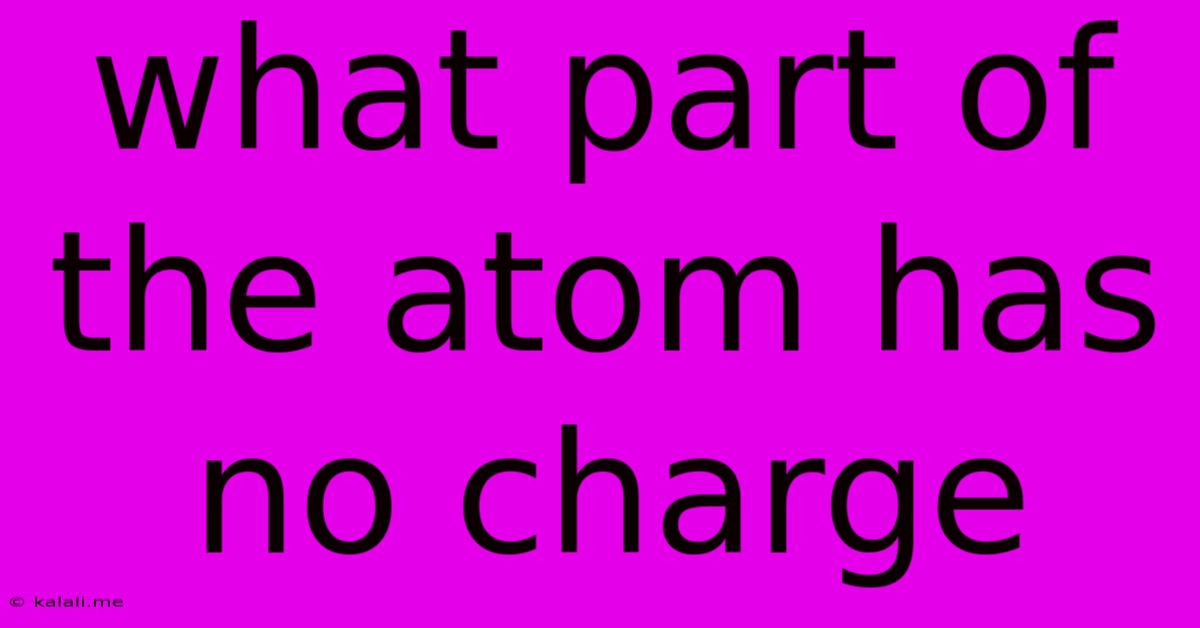What Part Of The Atom Has No Charge
Kalali
Jun 12, 2025 · 3 min read

Table of Contents
What Part of the Atom Has No Charge? Understanding Neutrons
The atom, the fundamental building block of matter, is composed of three primary subatomic particles: protons, electrons, and neutrons. While protons carry a positive charge and electrons carry a negative charge, neutrons are electrically neutral, meaning they possess no charge whatsoever. This seemingly simple characteristic plays a crucial role in the atom's overall stability and properties. This article will delve deeper into the nature of neutrons, exploring their mass, location within the atom, and their significance in nuclear physics.
Understanding the properties of neutrons is essential for grasping fundamental concepts in chemistry and physics. This article will answer the core question – what part of the atom has no charge? – and provide further insights into the neutron's role in atomic structure and nuclear reactions.
The Neutron: A Neutral Particle
As previously stated, the defining characteristic of a neutron is its lack of electrical charge. This neutrality distinguishes it from protons and electrons, which are charged particles that interact strongly with electromagnetic fields. This lack of charge significantly influences how neutrons interact with other particles and their behavior within the atom. Unlike charged particles that are easily deflected by electric and magnetic fields, neutrons are relatively unaffected, a property that is exploited in various scientific applications.
Location and Mass of Neutrons
Neutrons reside within the atom's nucleus, alongside protons. The nucleus is a densely packed region at the center of the atom, containing almost all of the atom's mass. While protons and neutrons contribute significantly to the atom's mass, neutrons are slightly heavier than protons. This mass difference is subtle but has implications for nuclear stability and radioactive decay. The combined mass of protons and neutrons determines the atomic mass number of an element.
The Role of Neutrons in Atomic Stability
The number of neutrons in an atom's nucleus significantly impacts its stability. Isotopes of an element have the same number of protons but differ in the number of neutrons. Some isotope combinations are stable, while others are unstable and undergo radioactive decay. This decay process often involves the emission of particles, including neutrons, leading to transformations in the atomic structure. The neutron-to-proton ratio plays a critical role in determining the stability of an atomic nucleus. Too many or too few neutrons can result in an unstable nucleus prone to radioactive decay.
Neutrons in Nuclear Reactions
Neutrons also play a vital role in nuclear fission and fusion reactions. In fission, a neutron striking a heavy atomic nucleus can cause the nucleus to split into smaller nuclei, releasing a tremendous amount of energy. This process is exploited in nuclear power plants. In fusion, light atomic nuclei combine to form heavier nuclei, also releasing substantial energy. This is the process that powers the sun. In both cases, neutrons are crucial participants, initiating and sustaining these powerful reactions.
Conclusion: The Significance of Neutrality
In conclusion, the neutron, a subatomic particle residing in the atom's nucleus, is uniquely characterized by its absence of electrical charge. This neutrality is not merely a trivial characteristic; it plays a fundamental role in atomic structure, nuclear stability, and nuclear reactions. Understanding the properties and behavior of neutrons is essential to a complete comprehension of atomic physics and its vast implications across various scientific fields. The neutrality of the neutron profoundly affects its interactions with other particles and its role in shaping the universe as we know it.
Latest Posts
Latest Posts
-
The Audible Range For Humans Is
Jun 13, 2025
-
Difference In Mitosis In Plant And Animal Cells
Jun 13, 2025
-
Choose One Of The Options To Replace The Missing Square
Jun 13, 2025
-
Polar Moment Of Inertia Hollow Cylinder
Jun 13, 2025
-
How Many Gigabytes Is In One Terabyte
Jun 13, 2025
Related Post
Thank you for visiting our website which covers about What Part Of The Atom Has No Charge . We hope the information provided has been useful to you. Feel free to contact us if you have any questions or need further assistance. See you next time and don't miss to bookmark.